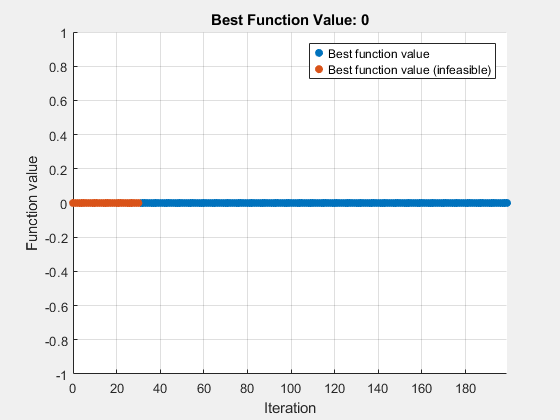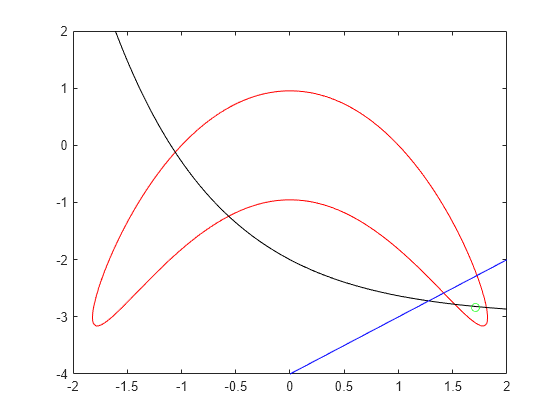使用 surrogateopt 解决可行性问题,基于问题
有些问题要求您找到一个满足所有约束的点,而没有目标函数需要最小化。例如,假设您有以下约束:
是否有任何点 满足约束?要回答这个问题,您需要评估各个点的表达。surrogateopt 求解器不需要您提供初始点,它会搜索广泛的点集。因此,surrogateopt 可以很好地解决可行性问题。
要可视化约束,请参阅可视化约束。有关该问题的基于求解器的方法,请参阅 解决可行性问题。
注意:此示例使用了两个辅助函数,outfun 和 evaluateExpr。本示例末尾提供了每个函数的代码。确保每个函数的代码都包含在脚本的末尾或路径上的文件中。
建立可行性问题
对于基于问题的方法,创建优化变量 x 和 y,并为列出的约束创建表达式。要使用 surrogateopt 求解器,您必须为所有变量设置有限边界。设置下界为 -10,上界为 10。
x = optimvar("x","LowerBound",-10,"UpperBound",10); y = optimvar("y","LowerBound",-10,"UpperBound",10); cons1 = (y + x^2)^2 + 0.1*y^2 <= 1; cons2 = y <= exp(-x) - 3; cons3 = y <= x - 4;
创建一个优化问题并将约束包含在问题中。
prob = optimproblem("Constraints",[cons1 cons2 cons3]);该问题没有目标函数。在内部,求解器将每个点的目标函数值设置为 0。
求解问题
使用 surrogateopt 求解问题。
rng(1) % For reproducibility [sol,fval] = solve(prob,"Solver","surrogateopt")
Solving problem using surrogateopt.

surrogateopt stopped because it exceeded the function evaluation limit set by 'options.MaxFunctionEvaluations'.
sol = struct with fields:
x: 1.7435
y: -3.1255
fval = 0
前几个评估点是不可行的,如图中红色所示。经过大约 60 次评估后,求解器会找到一个可行点,以蓝色绘制。
检查返回的解的可行性。
infeasibility(cons1,sol)
ans = 0
infeasibility(cons2,sol)
ans = 0
infeasibility(cons3,sol)
ans = 0
所有不可行性均为零,表明点 sol 是可行的。
在第一个可行点处停止求解器
为了更快地找到解,请创建一个输出函数(请参阅输出函数),当求解器达到可行点时,它会停止求解器。此示例末尾的 outfun 辅助函数在到达没有约束违反的点时停止求解器。
使用 outfun 输出函数解决问题。
opts = optimoptions("surrogateopt","OutputFcn",@outfun); rng(1) % For reproducibility [sol,fval] = solve(prob,"Solver","surrogateopt","Options",opts)
Solving problem using surrogateopt.

Optimization stopped by a plot function or output function.
sol = struct with fields:
x: 1.7435
y: -3.1255
fval = 0
这次,求解器比以前停止得更早。
可视化约束
为了可视化约束,使用 fimplicit 绘制每个约束函数为零的点。fimplicit 函数将数值传递给其函数,而 evaluate 函数需要一个结构体。要将这些函数绑定在一起,请使用 evaluateExpr 辅助函数,它出现在本示例的末尾。此函数只是将传递的值放入具有适当名称的结构体中。
避免由于 evaluateExpr 函数不适用于向量化输入而出现警告。将返回的解点绘制为绿色圆圈。
s = warning('off','MATLAB:fplot:NotVectorized'); figure cc1 = (y + x^2)^2 + 0.1*y^2 - 1; fimplicit(@(a,b)evaluateExpr(cc1,a,b),[-2 2 -4 2],'r') hold on cc2 = y - exp(-x) + 3; fimplicit(@(a,b)evaluateExpr(cc2,a,b),[-2 2 -4 2],'k') cc3 = y - x + 4; fimplicit(@(x,y)evaluateExpr(cc3,x,y),[-2 2 -4 2],'b') plot(sol.x,sol.y,'og') hold off

warning(s);
可行区域位于红色轮廓内、黑线和蓝线下方。可行区域位于红色轮廓的右下方。
辅助函数
以下代码创建 outfun 辅助函数。
function stop = outfun(~,optimValues,state) stop = false; switch state case 'iter' if optimValues.currentConstrviolation <= 0 stop = true; end end end
以下代码创建 evaluateExpr 辅助函数。
function p = evaluateExpr(expr,x,y) pt.x = x; pt.y = y; p = evaluate(expr,pt); end
另请参阅
solve | infeasibility | surrogateopt